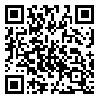Fri, Jul 18, 2025
[Archive]
Volume 20, Issue 1 (March 2024)
IJEEE 2024, 20(1): 72-82 |
Back to browse issues page
Download citation:
BibTeX | RIS | EndNote | Medlars | ProCite | Reference Manager | RefWorks
Send citation to:



BibTeX | RIS | EndNote | Medlars | ProCite | Reference Manager | RefWorks
Send citation to:
Khodsuz M. Frequency Grounding System Effect on the EGLAs Placement in a 400 kV Transmission Line. IJEEE 2024; 20 (1) :72-82
URL: http://ijeee.iust.ac.ir/article-1-3055-en.html
URL: http://ijeee.iust.ac.ir/article-1-3055-en.html
Abstract: (1744 Views)
In this paper, the performance of the EGLA (Externally Gaped Line Arresters) and its impact on the back flashover rate of a 400 kV transmission line have been investigated. The frequency behavior of the grounding system and soil resistivity has been modeled. To analyze the EGLA performance in relation to the grounding system's frequency behavior, a rod-shaped grounding system model has been implemented. By placing the EGLA at different phases of the transmission line, the best scenario has been identified to minimize back-flashover occurrences. Furthermore, the performance of the frequency grounding system to that of the nonlinear grounding system has been compared. The results clearly indicate that using a nonlinear grounding system leads to higher back flashover rates compared to the frequency grounding system. Additionally, the EGLA absorbs less energy when connected to a nonlinear resistor compared to the frequency grounding system. It can be concluded that modeling the grounding system's frequency behavior using the frequency grounding model provides more accurate results, especially in investigations related to power grid insulation coordination.
Keywords: Externally Gapped Line Arrester, Frequency Grounding System, Lightning Performance, Transmission Line.
Type of Study: Research Paper |
Subject:
Overhead Line Modeling
Received: 2023/09/08 | Revised: 2024/08/31 | Accepted: 2024/02/18
Received: 2023/09/08 | Revised: 2024/08/31 | Accepted: 2024/02/18
| Rights and permissions | |
 |
This work is licensed under a Creative Commons Attribution-NonCommercial 4.0 International License. |








